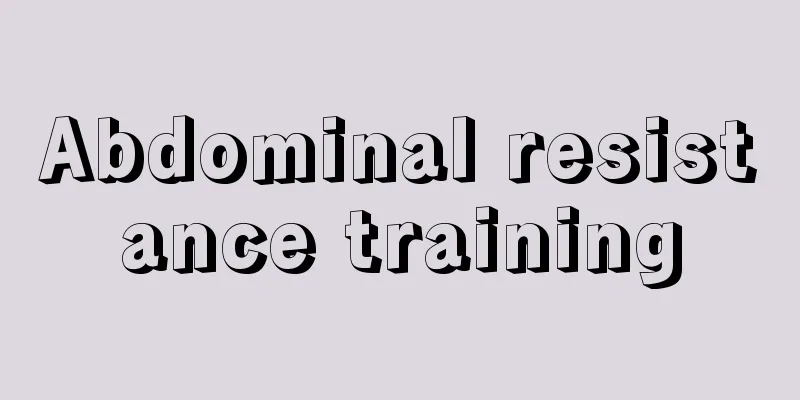What is the arm bar exercise method

|
Arm bars are a fitness method that many people choose, because arm bars are not restricted by the training venue or time. You can exercise at home whenever you want. It is best not to do strenuous exercise one hour before going to bed to avoid affecting sleep quality. But if you use arm bars to exercise, you don’t have to worry about this problem. Next, let’s take a look at how to use arm bars for exercise! (1) Reverse high tension curl This unusual but extremely effective exercise relaxes your lower back while allowing you to avoid the pitfalls of relying on momentum and swaying to maximize the use of your elbow flexors. Starting position: Place a bench perpendicular to the puller and hang a short bar (preferably with a rotatable cover) on the high pulley. Lie on your back on a bench with your head close to the puller. Stretch your arms up perpendicular to your body, and hold the horizontal bar with your hands about the width of a hand. Movement: Keeping your upper arms steady, gently bend your elbows and pull the bar toward your forehead. Pull down as hard as you can while your biceps are contracted to their maximum, then slowly return to the starting position. (2) Supine cable curl In this sport, it is difficult to take advantage of other parts of the body to gain shortcuts. You can try changing your grip to get the best workout. Starting position: Choose a medium-length horizontal bar (preferably with a rotating cover) and hang it on the low pulley. Lie on your back with your arms straight, hold the horizontal bar with both hands, bend your knees, and push the base of the tensioner with your feet. Place your hands on your thighs with your palms facing up and pass the rope between your legs (but not touching). Action: Keep your upper arms at your sides, shoulders close to the ground, elbows bent, and biceps used to pull the bar up to above your shoulders. Maintain a natural bend in your lower back as you return to the starting position. (3) Lateral curl with cable This movement is similar to the dumbbell side curl. It focuses on training an important muscle in the forearm - the flexor brachialis. Starting position: Hang a rope bundle on the low pulley, stand in front of the tensioner, slightly to one side. Hold one end of the rope in one hand, palm facing inward, and arm fully extended at the side of the body. Action: Bend your elbows and pull the rope toward your shoulders, keeping your wrists in the same position (do not turn your wrists, keep your palms facing inward). At the top of the pull, your thumb should be closest to your shoulder. Keep your elbows tight to your side to secure. Then slowly put it back in place. Alternate arms. (4) Cable curl This movement combines some of the advantages of barbell and dumbbell exercises. The exercise range includes all three muscles of the arm curl, but the emphasis is on the biceps. Starting position: Hang a rope bundle on the low pulley, stretch your arms straight, and hold one end of the rope in each hand with your palms facing inward. Action: Keep your upper arm stationary, bend your elbow, and pull the rope toward your shoulder. As you pull up, smoothly roll your wrists so your palms face up. When the movement is complete, your palm should be facing you. (5) Prone tensioner curl This movement retains the advantages of the traditional prone curl while changing the pulling line so that resistance exists throughout the entire movement. Starting position: Stand in front of the puller with your body perpendicular to it, and the arm to be exercised should be close to it, about 45-60 cm. Grab one of the handles on the low pulley, bend your knees slightly, and lean forward slightly. Action: Keep your upper arms as still as possible, bend your elbows, and use your biceps to pull the handles across your chest toward your shoulders. When you reach the maximum contraction position, your elbows should be pointing directly toward the low pulley. Then return to the starting position. Alternate arms. The above are some training methods for arm bars (puller bars). Be sure to wear wrist guards before using them to avoid muscle stretching. If you want to effectively avoid injuries, you should choose an arm bar that suits your strength and focus on the quantity rather than the strength. If the child is not yet an adult, it is best not to use the arm bar to avoid injury. |
<<: How to train jumping ability?
>>: How to use arm bars to train chest muscles
Recommend
What are some ways to exercise your muscles?
Having a strong body of muscles is probably every...
This is how you should exercise to nourish the kidneys, strengthen the essence and strengthen the waist
Kidney-strengthening exercises must be no strange...
What exercise burns fat quickly?
If you want to lose weight, the most important th...
What kind of indoor exercise can I do to lose weight?
Society is progressing, but in comparison, we hav...
Tips for aerobic exercise to slim your face
Doing more aerobic exercise is beneficial to our ...
Five-step aerobics
Aerobics is a very beneficial behavior for the hu...
Is brisk walking an aerobic exercise?
Aerobic exercise can be said to be a popular word...
How to do outdoor activities well
Only by insisting on doing outdoor exercise can y...
How to train the deltoid muscles of the arms
In today's social life, there are too many pr...
Yoga mat thickness
A yoga mat is an essential item for practicing yo...
What kind of exercise can make people grow taller?
When we were young, we would feel very inferior i...
How many calories will you burn by jogging for half an hour?
Many people particularly like the sport of joggin...
What are some ways to lose weight through exercise in one month?
Losing weight has become everyone's most anxi...
How to build strength?
In daily life, many people improve their strength...
Does playing basketball make you taller? Why?
There is a basketball court downstairs from my ho...









